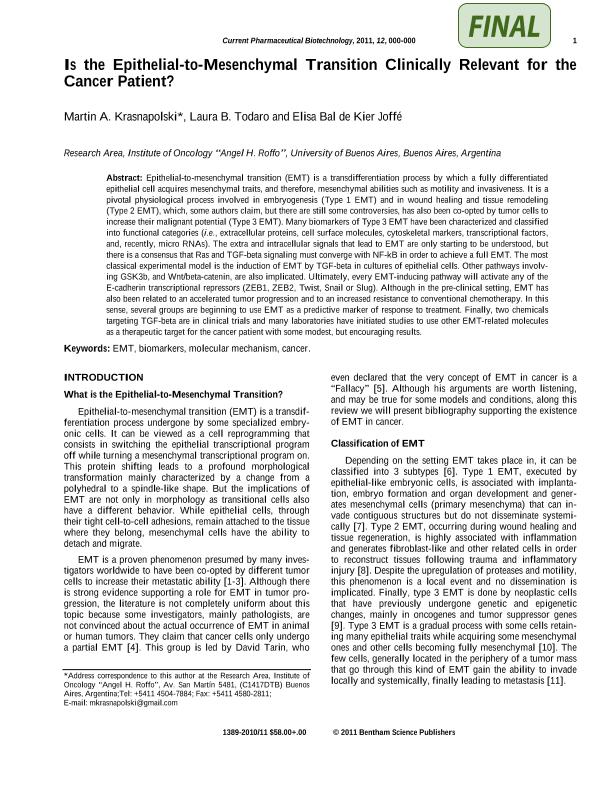Mostrar el registro sencillo del ítem
dc.contributor.author
Krasnapolski, Martin Alejandro

dc.contributor.author
Todaro, Laura Beatriz

dc.contributor.author
Bal, Elisa Dora

dc.date.available
2017-02-24T18:31:02Z
dc.date.issued
2011-04
dc.identifier.citation
Krasnapolski, Martin Alejandro; Todaro, Laura Beatriz; Bal, Elisa Dora; Is the Epithelial-to-Mesenchymal Transition Clinically Relevant for the Cancer Patient?; Bentham Science Publishers; Current Pharmaceutical Biotechnology; 12; 11; 4-2011; 1891-1899
dc.identifier.issn
1389-2010
dc.identifier.uri
http://hdl.handle.net/11336/13377
dc.description.abstract
Abstract: Epithelial-to-mesenchymal transition (EMT) is a transdifferentiation process by which a fully differentiated epithelial cell acquires mesenchymal traits, and therefore, mesenchymal abilities such as motility and invasiveness. It is a pivotal physiological process involved in embryogenesis (Type 1 EMT) and in wound healing and tissue remodeling (Type 2 EMT), which, some authors claim, but there are still some controversies, has also been co-opted by tumor cells to increase their malignant potential (Type 3 EMT). Many biomarkers of Type 3 EMT have been characterized and classified into functional categories (i.e., extracellular proteins, cell surface molecules, cytoskeletal markers, transcriptional factors, and, recently, micro RNAs). The extra and intracellular signals that lead to EMT are only starting to be understood, but there is a consensus that Ras and TGF-beta signaling must converge with NF-kB in order to achieve a full EMT. The most classical experimental model is the induction of EMT by TGF-beta in cultures of epithelial cells. Other pathways involving GSK3b, and Wnt/beta-catenin, are also implicated. Ultimately, every EMT-inducing pathway will activate any of the E-cadherin transcriptional repressors (ZEB1, ZEB2, Twist, Snail or Slug). Although in the pre-clinical setting, EMT has also been related to an accelerated tumor progression and to an increased resistance to conventional chemotherapy. In this sense, several groups are beginning to use EMT as a predictive marker of response to treatment. Finally, two chemicals targeting TGF-beta are in clinical trials and many laboratories have initiated studies to use other EMT-related molecules as a therapeutic target for the cancer patient with some modest, but encouraging results.
dc.format
application/pdf
dc.language.iso
eng
dc.publisher
Bentham Science Publishers

dc.rights
info:eu-repo/semantics/openAccess
dc.rights.uri
https://creativecommons.org/licenses/by-nc-sa/2.5/ar/
dc.subject
Emt
dc.subject
Biomarkers,
dc.subject
Molecular Mechanism
dc.subject
Cancer.
dc.subject.classification
Otras Ciencias de la Salud

dc.subject.classification
Ciencias de la Salud

dc.subject.classification
CIENCIAS MÉDICAS Y DE LA SALUD

dc.title
Is the Epithelial-to-Mesenchymal Transition Clinically Relevant for the Cancer Patient?
dc.type
info:eu-repo/semantics/article
dc.type
info:ar-repo/semantics/artículo
dc.type
info:eu-repo/semantics/publishedVersion
dc.date.updated
2017-02-15T14:09:48Z
dc.journal.volume
12
dc.journal.number
11
dc.journal.pagination
1891-1899
dc.journal.pais
Emiratos Árabes Unidos

dc.journal.ciudad
Sharjah
dc.description.fil
Fil: Krasnapolski, Martin Alejandro. Universidad de Buenos Aires. Facultad de Medicina. Instituto de Oncologia "Angel H. Roffo"; Argentina. Consejo Nacional de Investigaciones Científicas y Técnicas. Oficina de Coordinación Administrativa Houssay; Argentina
dc.description.fil
Fil: Todaro, Laura Beatriz. Universidad de Buenos Aires. Facultad de Medicina. Instituto de Oncologia "Angel H. Roffo"; Argentina. Consejo Nacional de Investigaciones Científicas y Técnicas. Oficina de Coordinación Administrativa Houssay; Argentina
dc.description.fil
Fil: Bal, Elisa Dora. Universidad de Buenos Aires. Facultad de Medicina. Instituto de Oncologia "Angel H. Roffo"; Argentina. Consejo Nacional de Investigaciones Científicas y Técnicas. Oficina de Coordinación Administrativa Houssay; Argentina
dc.journal.title
Current Pharmaceutical Biotechnology

dc.relation.alternativeid
info:eu-repo/semantics/altIdentifier/url/http://www.eurekaselect.com/75843/article
dc.relation.alternativeid
info:eu-repo/semantics/altIdentifier/doi/http://dx.doi.org/10.2174/138920111798377021
Archivos asociados
